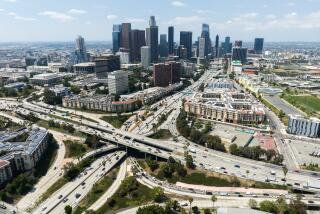Everyone Pays for Troubled Subway Project
- Share via
Whether you live in Long Beach or Palmdale, you should care about the Los Angeles subway project.
You’re paying for it.
Every time you buy anything taxable in Los Angeles County, one cent of every dollar goes to the Metropolitan Transportation Authority.
This week, county Supervisor and MTA board member Zev Yaroslavsky said that he is considering a petition drive to repeal the pair of half-penny tax increases or redirect the $866 million in annual receipts to improve service on the nation’s most crowded bus system.
Others have suggested that some of the money be used to roll back the $1.35 bus fare to the 50-cent level in effect during the mid-1980s, when bus ridership was at an all-time high.
The bulk of the money already goes to bus operations, but Yaroslavsky said it may be time to stop the MTA from committing any more sales tax money to rail construction. The agency has set aside $179 million in this year’s budget to pay off bonds, mostly for rail construction, and Yaroslavsky said the amount will probably increase next year.
Yaroslavsky said his San Fernando Valley constituents have paid more than a billion dollars since voters approved the tax increases in 1980 and 1990.
“What do they have to show for it?” he asked. “A Red Line station at North Hollywood. And all signs point to nothing for the next 15 or 20 years.”
The Valley and other areas are facing even longer waits for rail lines as the MTA struggles with a shortfall in federal funding for the subway and unanticipated costs to comply with a court order to expand bus service.
Yaroslavsky said that putting the tax on the ballot would be the “2-by-4” to jar the MTA into “being a responsive agency for the entire county rather than a pork barrel for a handful of interest groups and board members.”
Now, the bulk of the sales tax money must be spent according to a formula that can only be changed by voters.
For example, 25% of the funds from Proposition A, the first half-penny tax, goes to cities and the county for transit projects, such as municipal bus lines and dial-a-ride services; and 35% goes to construction and operation of rail lines. The MTA board has chosen to spend the remaining 40% discretionary pot to improve bus service.
Of the Proposition C pot, 20% goes to cities and the county; 25% goes to street-related transit improvements, such as construction of bus and carpool lanes; 5% goes to transit security; and 10% goes to the park-and-ride lots, transit centers and commuter rail operations. Again, the MTA can spend 40% anyway it wants. A portion of that goes to bonds, which will pay for $400 million of rail construction this year.
Bus rider advocates say that setting aside more tax money for bus service would assure that the agency could comply with a court order requiring improvements in bus service. The court order was won by minority and poor bus riders who said the MTA was pursuing costly rail projects while slighting a bus system that serves 10 times as many riders.
Even bus advocates seeking more money for bus operations say it may not be worth the gamble to ask voters if they want to spend the money any differently.
After all, voters may decide they don’t want to spend the money at all and repeal the measures.
(BEGIN TEXT OF INFOBOX / INFOGRAPHIC)
The Taxes
Sales tax revenues from Propositons A and C:
(in millions)
Buses
MTA: $182
Regional: $97
*
Rail
Operations: $55
Construction: $2
*
Commuter Rail: $50
Freeway Service: $26
Carpool Lanes and Other Transit Projects: $154
City / County Transit Programs: $188
Debt: $179
Planning & Other: $78
This Year: $866
Carry- Over From Last Year: $145
Total: $1 billion
Source: MTA
More to Read
Sign up for Essential California
The most important California stories and recommendations in your inbox every morning.
You may occasionally receive promotional content from the Los Angeles Times.











